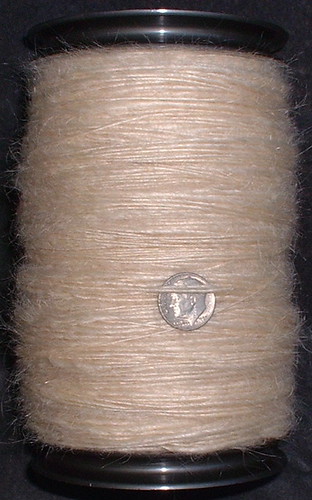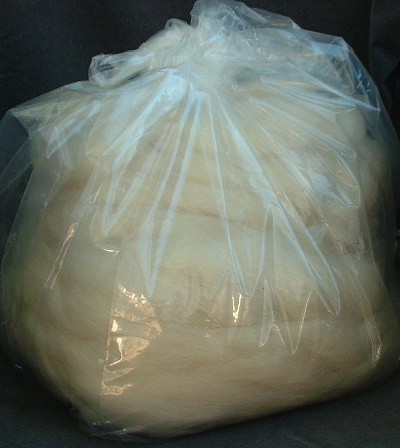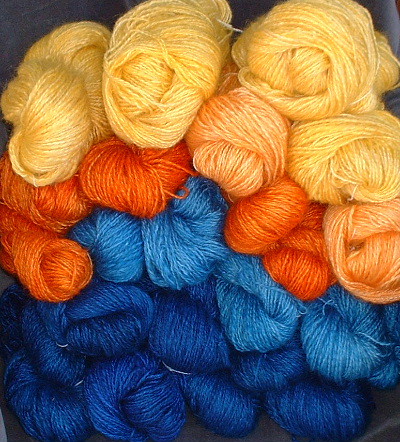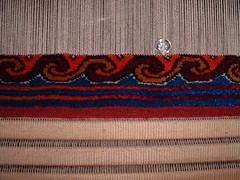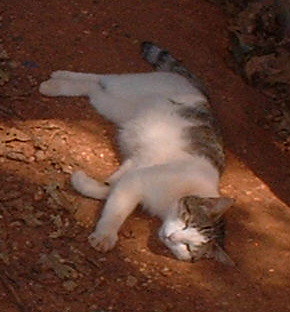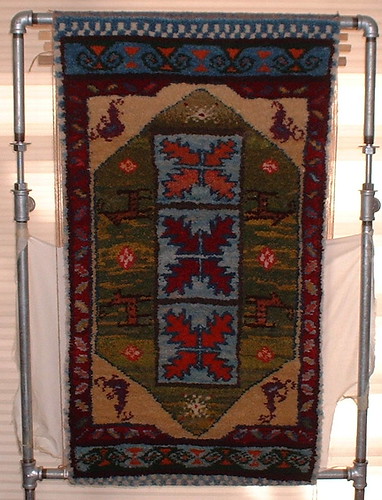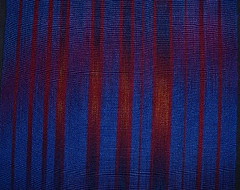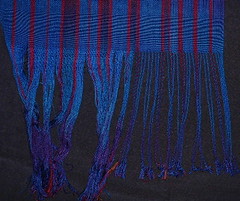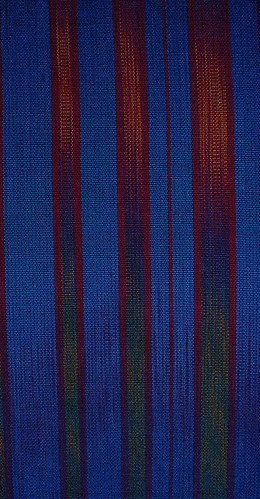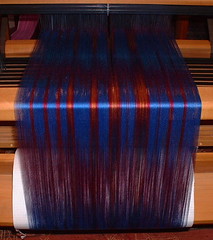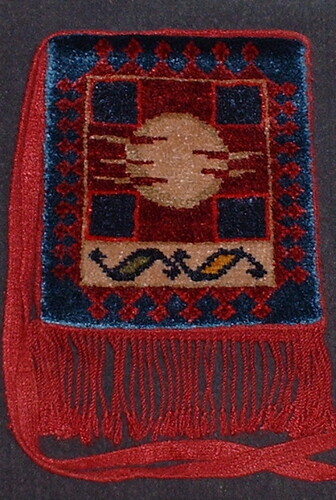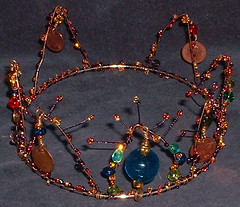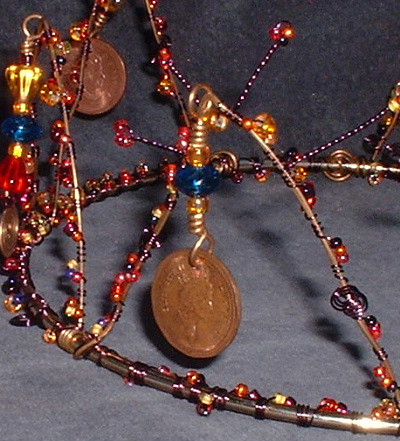Diversions, or How I Can Make a Simple Task Expand
I have spent the week preparing warps, dyeing warps, warping warps, and weaving warps for this fabric:

It is silk, 120/8 reeled tussah from Treenway, woven at 48 epi, with a cotton 20/2 weft. This is a new yarn to me, and has a distinctly crisp feel: the 120/8 is not a simple plied yarn: it is 4 two-element plied yarns, plied back on themselves (4 zzS plied Z). I learned to call this yarn structure *crepe yarn* from Ted Carson, way back in the dark ages, in a class he taught in February 1981 (yes! I still have my notes).
The hand of this yarn is pebbly, or bumpy, not smooth as a reeled yarn would be expected to be. The more I worked with it, the more curious I became as to its final *handle* in the fabric. So today, as I started to weave, I found out. It feels nubby. Crisp, but not smooth, it is interesting.
It reminded me of an old kimono I have:
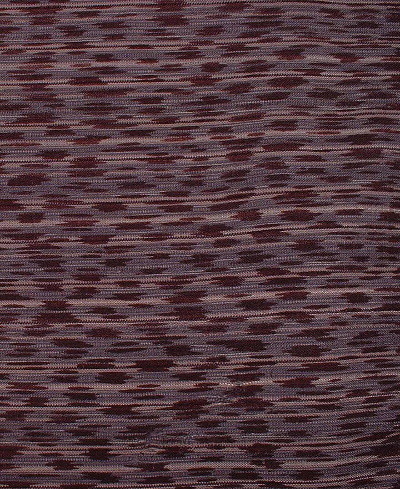
the fabric of which always had a slightly *not smooth* texture: not rough, but not smooth, similar to what I am weaving now.
The kimono is old and worn enough to have holes in it, from which I pulled a couple of very fine threads (gasp!), to see if the yarn structure was the same as what I am using. The best I could tell, from the tiny pieces I extracted (they broke as I pulled them out) is that this is made of a spun yarn (short fibers) in a two element construction, but with both elements spun and plied in the same direction, to make them very tight and cord-like. But not the same as my 120/8 yarns.
Must Investigate Further. Diane Varney describes a crepe yarn as a 3 element technique: a 2Z plied S then re-plied with an S single(non-spinners have now glazed over). My notes from Ted Carson say that a crepe is a 2Z plied S and the reply two of the resulting elements as a 4Z. If loosely plied, this is called knitting crepe, tightly plied is called a cord or cable yarn (which term Varney uses too). I know many knitters who simply call this construction a cable yarn, twist amount notwithstanding. So who is right, and just what is crepe yarn, or cable yarn?
Next, I pull out long dead Aunt Gladys' yarns from the early '50's (yes! I have too much stuff!) and lo and behold:
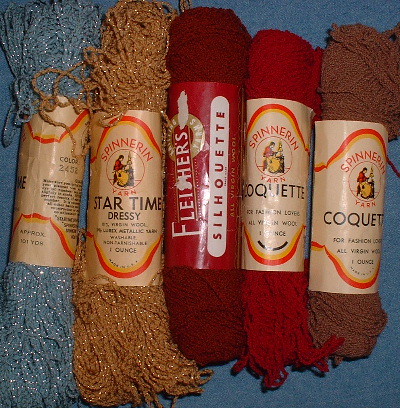
All are 4 plies: 2 elements plied together, then 2 of these re-plied to make a 4 element construction. The 2 ply yarns are spiral yarns, though, two elements held under different tension when plying. This gives the final construction, and the resulting fabric (yes! I have 50 year old swatches! Why throw *anything* away!) a pebbly texture, much like my woven fabric. Is this knitting crepe? None are labeled crepe, cable, cord or anything but Virgin Wool.
Hmmm. Just what does crepe mean? Is it a yarn? Is it a fabric structure? We repair to the weaving books: No mention in either Helene Bress, or Mary Black, of crepe fabric.
In Irene Emery, no fabric is mentioned, but she describes *crepe twist yarns* as high twist singles, which, when woven, "produce a creped or crepe-y effect" fabric. I know many weavers think of highly twisted yarns woven in plain weave as crepe fabric: obviously this has nothing to do with the terminology used by spinners.
And is spinning jargon yet again different from knitting jargon? Why, yes! How else would one explain the *worsted yarn* terminology variations or (excuse me?) *double knitting*? And is *sport yarn* a hold over from tennis, or from cricket? How many other sports wear sweaters? Oh, OK, skiing.
To make matters more interesting: Ted Carson was a Canadian. Is this that old *separated by a common language* issue??
You see how far off track I have gotten. And are we any better for it? No. But we have taken up precious weaving time. And this is for a deadline, mind you. Back to the fabric at hand:
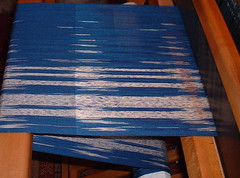
In this photo you can see the blue in the ikat stripes is (gasp!) darker. It is the same yarns, degummed and processed in the same pot at the same time as the plain blue warps. But it is darker blue. The only thing I can think of is that the ikat tape that it was tied with:
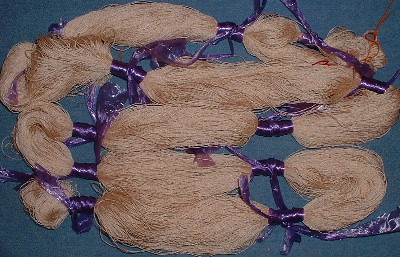
held it down in the pot, therefore getting more heat faster, and the dye striking first. Another hmmm.
Another surprise: the golden tussah color largely washed out in the degumming. The colors in the two photos above show this well: the golden tussah is, sadly, much lighter. It also shows here in the braided area before degumming:
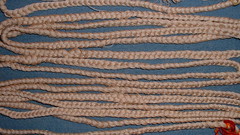
And after dyeing:
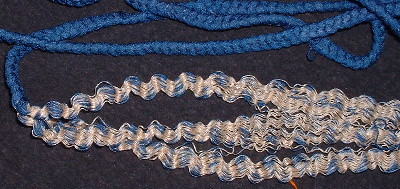
You can see, even in the resisted areas, the yarn is much whiter.
These unbraided yarns work up into the mottled area in the fabric. I first learned this braid/dye/unbraid and weave technique from Vicky Jensen, who now works at ProChem. Vicky has an MFA in fibers, and several of the fabrics from her master's project had this nice braided/dyed feature.
Alas, no definitive answers to all this rummaging through my library, my storage closet and Aunt Gladys' old knitting supplies. But it *is* interesting, at least to me, and has kept me occupied during the hours of prep leading up to this fabric. Any clarifications/further obfuscations gladly accepted. And now to weave.

It is silk, 120/8 reeled tussah from Treenway, woven at 48 epi, with a cotton 20/2 weft. This is a new yarn to me, and has a distinctly crisp feel: the 120/8 is not a simple plied yarn: it is 4 two-element plied yarns, plied back on themselves (4 zzS plied Z). I learned to call this yarn structure *crepe yarn* from Ted Carson, way back in the dark ages, in a class he taught in February 1981 (yes! I still have my notes).
The hand of this yarn is pebbly, or bumpy, not smooth as a reeled yarn would be expected to be. The more I worked with it, the more curious I became as to its final *handle* in the fabric. So today, as I started to weave, I found out. It feels nubby. Crisp, but not smooth, it is interesting.
It reminded me of an old kimono I have:

the fabric of which always had a slightly *not smooth* texture: not rough, but not smooth, similar to what I am weaving now.
The kimono is old and worn enough to have holes in it, from which I pulled a couple of very fine threads (gasp!), to see if the yarn structure was the same as what I am using. The best I could tell, from the tiny pieces I extracted (they broke as I pulled them out) is that this is made of a spun yarn (short fibers) in a two element construction, but with both elements spun and plied in the same direction, to make them very tight and cord-like. But not the same as my 120/8 yarns.
Must Investigate Further. Diane Varney describes a crepe yarn as a 3 element technique: a 2Z plied S then re-plied with an S single(non-spinners have now glazed over). My notes from Ted Carson say that a crepe is a 2Z plied S and the reply two of the resulting elements as a 4Z. If loosely plied, this is called knitting crepe, tightly plied is called a cord or cable yarn (which term Varney uses too). I know many knitters who simply call this construction a cable yarn, twist amount notwithstanding. So who is right, and just what is crepe yarn, or cable yarn?
Next, I pull out long dead Aunt Gladys' yarns from the early '50's (yes! I have too much stuff!) and lo and behold:

All are 4 plies: 2 elements plied together, then 2 of these re-plied to make a 4 element construction. The 2 ply yarns are spiral yarns, though, two elements held under different tension when plying. This gives the final construction, and the resulting fabric (yes! I have 50 year old swatches! Why throw *anything* away!) a pebbly texture, much like my woven fabric. Is this knitting crepe? None are labeled crepe, cable, cord or anything but Virgin Wool.
Hmmm. Just what does crepe mean? Is it a yarn? Is it a fabric structure? We repair to the weaving books: No mention in either Helene Bress, or Mary Black, of crepe fabric.
In Irene Emery, no fabric is mentioned, but she describes *crepe twist yarns* as high twist singles, which, when woven, "produce a creped or crepe-y effect" fabric. I know many weavers think of highly twisted yarns woven in plain weave as crepe fabric: obviously this has nothing to do with the terminology used by spinners.
And is spinning jargon yet again different from knitting jargon? Why, yes! How else would one explain the *worsted yarn* terminology variations or (excuse me?) *double knitting*? And is *sport yarn* a hold over from tennis, or from cricket? How many other sports wear sweaters? Oh, OK, skiing.
To make matters more interesting: Ted Carson was a Canadian. Is this that old *separated by a common language* issue??
You see how far off track I have gotten. And are we any better for it? No. But we have taken up precious weaving time. And this is for a deadline, mind you. Back to the fabric at hand:

In this photo you can see the blue in the ikat stripes is (gasp!) darker. It is the same yarns, degummed and processed in the same pot at the same time as the plain blue warps. But it is darker blue. The only thing I can think of is that the ikat tape that it was tied with:

held it down in the pot, therefore getting more heat faster, and the dye striking first. Another hmmm.
Another surprise: the golden tussah color largely washed out in the degumming. The colors in the two photos above show this well: the golden tussah is, sadly, much lighter. It also shows here in the braided area before degumming:

And after dyeing:

You can see, even in the resisted areas, the yarn is much whiter.
These unbraided yarns work up into the mottled area in the fabric. I first learned this braid/dye/unbraid and weave technique from Vicky Jensen, who now works at ProChem. Vicky has an MFA in fibers, and several of the fabrics from her master's project had this nice braided/dyed feature.
Alas, no definitive answers to all this rummaging through my library, my storage closet and Aunt Gladys' old knitting supplies. But it *is* interesting, at least to me, and has kept me occupied during the hours of prep leading up to this fabric. Any clarifications/further obfuscations gladly accepted. And now to weave.
